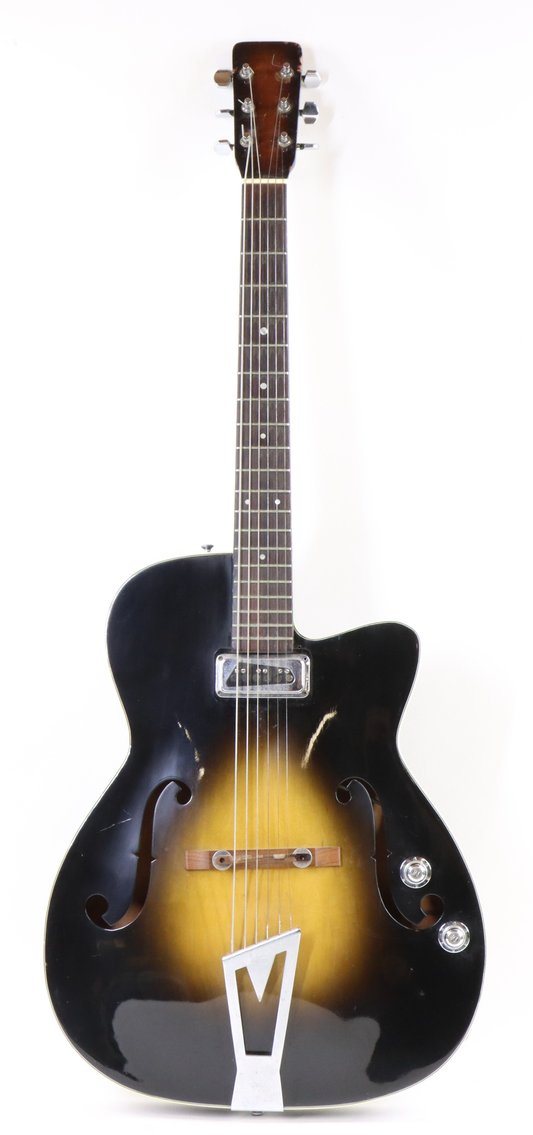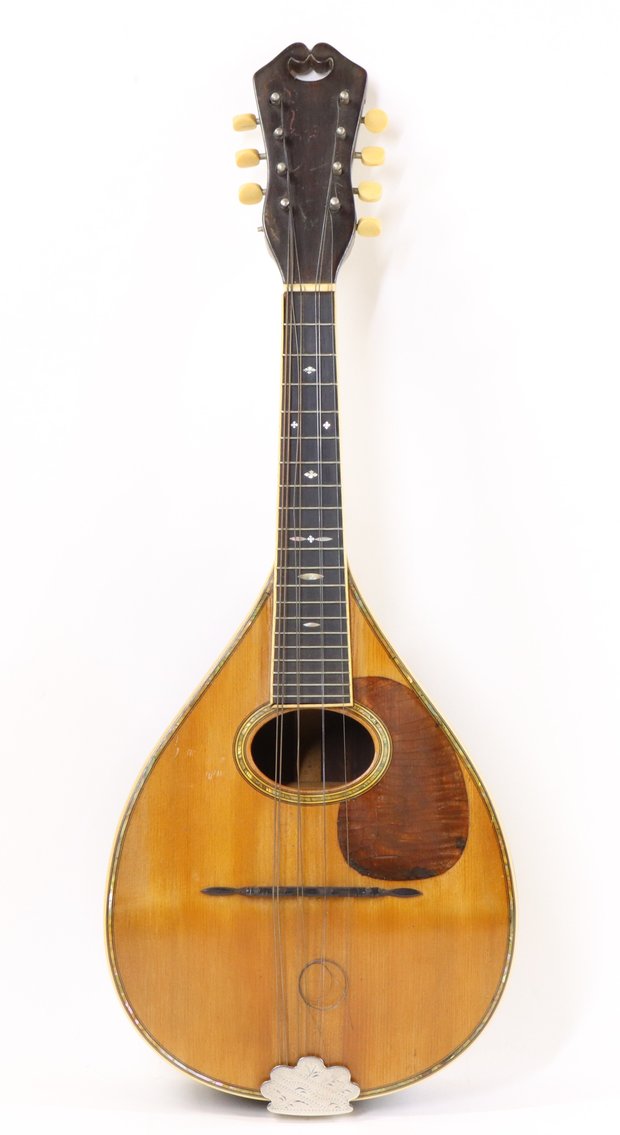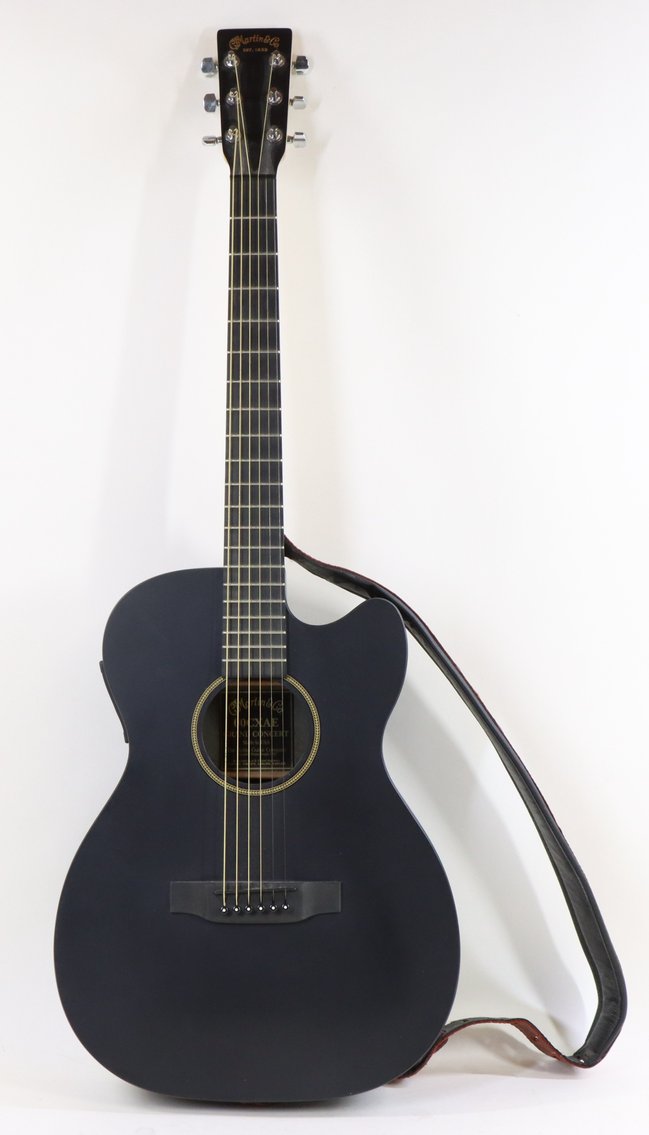Collecting Martin: What to Look For in Vintage and Modern Models

Collecting Martin: What to Look For in Vintage and Modern Models
Edited by: Christian Answini | Senior Fine Art Specialist
Martin guitars are pillars of American musical history. From the parlor guitars played in 19th‑century parlors to modern composite instruments and rare forays into electric design, the company’s instruments trace the evolution of popular music. Whether you’re a seasoned collector searching for a pre‑war treasure or a player looking for an affordable, durable Martin for regular use, understanding serial numbers, style designations, condition factors and market trends is essential. This guide uses four instruments from our upcoming Nov. 18th Musical Instruments Auction—a C.F. Martin F‑59 electric guitar, a Model “C” lute‑shaped mandolin (c. 1920), a Style 2 ½‑17 parlor guitar and a 00CXAE acoustic‑electric—as case studies to illuminate what collectors should look for.
Decoding Martin Serial Numbers
Dating a Martin instrument often begins with the serial number. Since 1898 Martin has stamped a serial number on the neck block or inside the body; the company provides a chart linking the last serial number of each year to the year of production. For example, serial numbers around 4000 indicate 1905 production, while numbers in the 250,000 range correspond to guitars built in the mid‑1970s. Instruments built before 1898—such as the 2 ½‑17 in our auction—were not serialized; these can be dated through internal stamps and construction clues. When verifying any vintage Martin, compare the serial number (if present) with the official chart and examine whether the neck block stamp matches the production era. Mandolins adopted the guitar serial‑number sequence in 1991, so a 1920s Style C will have its own series of numbers (commonly stamped on the neck block). The 00CXAE and the F‑series instruments should have serial numbers corresponding to their year of production—if the auction listing provides the number, cross‑check it to authenticate the build year.
Understanding Martin’s Style Designations
Martin model names consist of body size and style codes. According to the company, the model prefix (e.g., 0, 00, 000, D) describes the body size and shape; smaller numbers denote smaller guitars. An “F” prefix indicates a thin, semi‑hollow electric body, while letters such as LX denote Little Martin travel guitars. The number after the prefix represents the style or level of ornamentation: higher numbers correspond to more elaborate materials and decorative features. For instance, the 17‑style historically signified an all‑mahogany guitar, whereas 28‑style models used rosewood and featured more binding and inlay. Additional letters convey features: C means cutaway, E indicates onboard electronics and X identifies the X‑series with high‑pressure laminate (HPL) components. Understanding these codes helps collectors quickly assess an instrument’s construction and position in the Martin hierarchy.
Body sizes and the parlor example
The 2 ½‑17 guitar illustrates the body‑size designation. In the 19th century, Martin offered sizes 0 (concert), 1, 2 and even 2 ½; the latter is slightly narrower than the 0 size. The “17” style on our example, built circa 1867–1875, differs from later 17‑style instruments. Retrofret notes that before World War I, Style 17 guitars used a spruce top, Brazilian rosewood back and sides and a Spanish‑cedar neck—materials later reserved for higher‑end models. After the war, 17‑style instruments were built entirely of mahogany to keep costs down. Thus, the 2 ½‑17 in this auction offers materials usually associated with higher styles despite its modest designation.
Style letters: cutaways, electrics and X‑series
Martin’s F‑series electrics, produced from 1961–1965, use the F prefix to denote thin, semi‑hollow bodies with f‑holes. The F‑55 and F‑65 have two pickups; the F‑50 has one. For acoustic guitars, an E suffix indicates factory‑installed electronics and C denotes a cutaway; the 00CXAE uses both (00 size, cutaway body, electronics) along with X for the X‑series. Understanding these letters clarifies that the 00CXAE is a small‑bodied acoustic‑electric with HPL construction rather than a traditional all‑wood guitar.
Condition Factors and Collectibility
Condition and originality are central to a Martin’s value. A 1960s Fender Stratocaster with original finish, parts and tags can be worth several times more than a refinished example, illustrating how collectors value originality above all. Vintage guitar appraisers assess finish originality, structural integrity, hardware and electronics; even a repaired neck crack can reduce value by 40–60 percent. Refinishing or replacing parts on a Martin—such as converting a C‑series archtop to a flat‑top or replacing original tuners—can dramatically reduce its worth. When examining vintage Martins, look for signs of refinishing, overspray, replaced bridges or tuners and repaired cracks. Instruments with sympathetic repairs and minimal modifications command higher prices.
Market Trends
The vintage guitar market has grown steadily, but values vary widely by model and era. Pre‑war D‑28 guitars remain the most coveted; a recent analysis estimates that an ea,rly D‑28 can command around $185,000, with average annual returns of 8.3 percent. By contrast, 1970s D‑18 models can be found for roughly $3,500, offering an accessible entry point for collectors. The F‑series electrics were historically undervalued, but interest is increasing. Premier Guitar notes that F‑series instruments have historically ranked low on the collectability scale, yet recent examples have sold for more than $2,000—up from about $1,500 a few years ago. Mandolins and parlor guitars occupy niche markets; scarcity drives value. A forum discussion on the Unofficial Martin Guitar Forum records that only 393 rosewood Style C mandolins were made between 1914 and 1932—far fewer than the thousands of Style A instruments produced, making surviving examples especially collectible. Modern composite models like the 00CXAE are valued more for playability and durability than investment; they rarely appreciate like vintage instruments but offer a cost‑effective entry to the Martin brand.
Case Studies
1. C.F. Martin F‑59 Electric Guitar

The F‑59 in the auction is part of Martin’s short‑lived F‑series, introduced in 1961 when the company attempted to compete in the electric market. The series comprised three models—F‑50, F‑55 and F‑65—with the F‑55 sitting in the middle of the range. Each model shared key features: triple‑bound arched spruce tops, flat maple backs, thin bodies around two inches deep and DeArmond single‑coil pickups. The F‑50 had a single pickup; the F‑55 and F‑65 were equipped with two pickups, and the F‑65 added a second cutaway for easier upper‑fret access. Production numbers were low—estimates suggest 500–700 of each model were built before the line was discontinued in 1965.
A RetroFret listing for a 1961 F‑55 describes the model as a single‑cutaway guitar with two pickups, a triple‑bound sunburst body and a slim mahogany neck. It notes that the wiring uses individual tone and volume controls, and the chrome stamped tailpiece forms a stylized “M”. The F‑series had been ignored by collectors for decades, but improved recognition of their build quality and the desirability of vintage DeArmond pickups have pushed prices upward. When assessing an F‑59, verify that the DeArmond pickups and original tailpiece are intact; replacement pickups or hardware will reduce value. Check the serial number to confirm a 1961–1965 build, inspect the body for cracks and overspray and note the condition of the sunburst finish. While the F‑series does not command D‑28 prices, rarity and rising demand make a clean example an interesting addition to a collection.
2. C.F. Martin Model “C” Lute‑Shaped Mandolin (c. 1920)

Martin began producing mandolins in 1896; by 1914 the catalog offered flat‑backed, bowl‑bodied and lute‑shaped models. The Style C occupies the upper-middle of this range. The Blue Book of Guitar Values lists its specifications as a rosewood back and sides, spruce top, ivory front and back binding, an oval soundhole with colored purfling, a pearl rosette, a pickguard on the treble side, snowflake fingerboard inlays, an engraved German‑silver tailpiece and an ornate headstock. Compared with lower styles, the C has more intricate binding and inlay; compared with higher styles (D and above), it lacks pearl borders but retains elegance.
Production numbers of the Style C were low. The Unofficial Martin Guitar Forum notes that only 393 Style C mandolins were made between 1914 and 1932. Martin’s peak mandolin production occurred in 1920 with 734 Style A instruments produced, underscoring how rare the C is by comparison. For collectors, rarity and original condition drive value. Examine the instrument for cracks in the spruce top, repaired seams on the rosewood back, wear around the oval soundhole and the originality of the snowflake inlays and engraved tailpiece. The serial number (often stamped on the neck block) should correspond to the early 1920s. Because these mandolins used a flat back and bent top, they sound different from the carved‑top Gibsons of the era; players who appreciate a sweet, delicate tone may find them delightful.
3. C.F. Martin Style 2 ½‑17 Parlor Guitar
.jpeg)
The Style 2 ½‑17 represents an early Martin parlor guitar. Retrofret explains that 19th‑century Style 17 guitars were built with a spruce top, Brazilian rosewood back and sides and a Spanish‑cedar neck, unlike post‑war 17‑style instruments made entirely of mahogany. The 2 ½ size—a diminutive body less than 12 inches wide—was popular in the late 1800s but faded in the 20th century. A Vintage American Guitar listing for an 1869 example describes a fan‑braced Adirondack spruce top, Brazilian rosewood back and sides, original Jerome tuners, bar frets and an ebony pyramid bridge. The ice‑cream‑cone heel and hot‑stamped “C.F. Martin & Co. New York” logos help date the guitar to just after 1867.
These guitars lack serial numbers, so authentication relies on construction details and stamps. Collectors should check for fan bracing (rather than X‑bracing), the rope‑pattern rosette and five‑ply top binding. Condition is critical: the Retrofret example shows multiple sealed cracks, refinishing and a replaced bridge. While sympathetic repairs may be acceptable, heavy refinishing or non‑period bridges lower value. Because 2 ½‑17s were built for gut strings, fitting steel strings can damage the top; ensure that any conversion for modern strings has been done carefully. A well‑preserved parlor guitar offers a glimpse into early American lutherie and appeals to collectors seeking unique, playable instruments.
4. Martin 00CXAE Acoustic‑Electric

The 00CXAE illustrates Martin’s modern, budget‑friendly approach. Part of the X‑Series, it pairs a 00‑size thinbody cutaway with high‑pressure laminate (HPL) top, sides and back, a Stratabond neck and Fishman Classic 4 Sonicore electronics. According to zZounds’ product overview, the design emphasizes versatility and ease of play, offering a small body with active electronics and a long 25.4‑inch scale. The specs list HPL top and body, A‑frame bracing above the soundhole, a micarta fingerboard and bridge, and 14 frets clear of the body. This model carries no binding and uses a herringbone decal rosette rather than inlaid purfling. The instrument ships without a case and was marketed as an affordable stage guitar.
Because the 00CXAE uses laminate and synthetic materials, it does not have the same collectible appeal as all‑wood Martins. Instead, it represents an accessible choice for players who want the Martin logo and reliable electronics without the maintenance required by solid wood. Collectors should still verify the serial number and look for signs of heavy wear or delamination, but investment potential is limited. For those starting a collection, a modern X‑Series instrument can provide a reference point for how Martin’s design philosophy evolved and a durable guitar to enjoy while searching for vintage pieces.
Tips for New and Seasoned Collectors
- Authenticate with serial numbers and stamps. Check the neck block and interior stamps against Martin’s serial number chart. For pre‑1898 instruments, examine branding stamps and construction features such as the ice‑cream‑cone heel and fan bracing.
- Understand the model code. Learn the body size and style numbering to quickly assess materials and features. Remember that letters like C, E and X indicate cutaways, electronics and the X‑Series.
- Evaluate condition meticulously. Original finish and parts dramatically influence value. Hire a reputable luthier or appraiser to inspect cracks, repairs and non‑original hardware.
- Consider market context. Pre‑war D‑series Martins remain the blue‑chip investments, but lesser‑known models like the F‑series or Style C mandolins may offer growth potential because of their rarity. Modern X‑Series instruments offer durability but limited appreciation.
- Buy with your ears and heart. While investment potential is important, the joy of owning a guitar or mandolin that inspires you is invaluable. The deep, rich voice of a 2 ½‑17 or the sweet tone of a Style C mandolin will bring pleasure long after market prices have shifted.
Conclusion
Collecting Martin instruments blends history, craftsmanship and personal expression. By learning to decode serial numbers, understanding model designations, scrutinizing condition and monitoring market trends, you can navigate the vintage and modern offerings with confidence. The four pieces in the current auction—from a rare F‑series electric and a scarce Style C mandolin to a 19th‑century parlor guitar and a modern laminate acoustic‑electric—illustrate the remarkable range of Martin’s output. Each tells a story about changing musical tastes, materials and technology. Whether you bid for investment, historical interest or the sheer pleasure of owning a Martin, informed collecting ensures that these instruments continue to resonate for generations to come.










